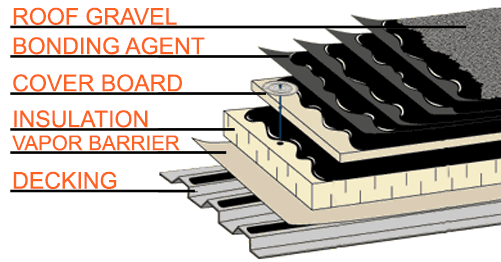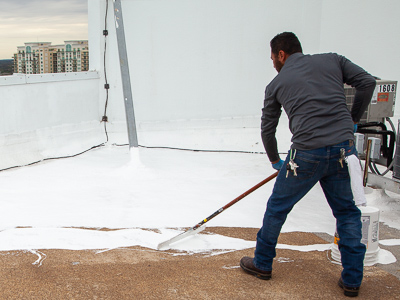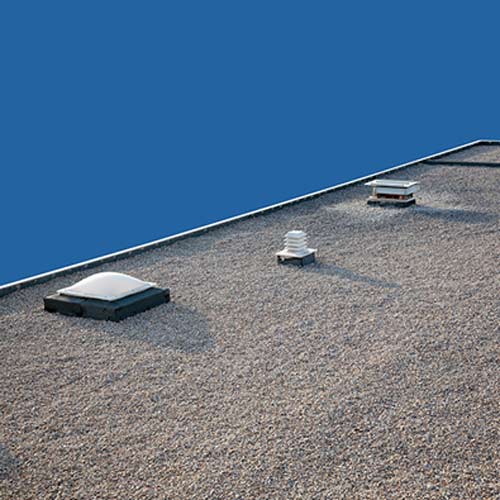What is a Built-up Roofing System?
Published: 08/24/2020

Built-up roofing (BUR) is a seamless, semi-flexible membrane composed of 2-5 built-up layers, or plies, of coated or fiberglass-reinforced fabrics layered and finished with bitumen (asphalt, cold-applied adhesive or hot coal tar).
Popular in commercial or other flat roofing systems, BUR has been used in the U.S. since the mid-1800s, reaching the height of its popularity in the 1970s. Commonly referred to as “tar and gravel” roofs, BUR systems are the preferred roofing methods used on low-slope roofs due to their seamless, sealed surface. Modern BUR systems implement a rigid layer for insulation and energy efficiency.
Built-up roofing is typically made of three main components: ply sheets, bitumen and surfacing materials. The bitumen acts as the ‘glue’ holding the layers together and can be either a hot bitumen - meaning it is heated so that it liquefies during installation - or it can be cold, which is not heated and can be sprayed or applied with a squeegee. Hot bitumen tends to give off harmful fumes, while cold bitumen does not.
Surfacing materials, which make up the top layer of the BUR system, typically consist of gravel or ballasted asphalt. This is the finishing layer and provides the finished look and helps protect the layers below from harmful elements like UV rays or falling objects, as well as making the roof safer to walk on. A ballasted asphalt finishing layer uses larger stones (about 1.5” - 2.5” in diameter) that are not attached to the roof structure, using its weight to hold the roofing in place, while gravel-finished surfaces are typically sealed with a final layer of coating to keep stones in place.
Types of BUR Applications
There are three main types of BUR applications:
- Hot asphalt BUR systems are applied by hot-mopping. The bitumen comes in solid form and is broken down into smaller pieces and heated in a 400-degree kettle until it melts into a liquid. The liquid bitumen is then mopped onto the roof and spread evenly. Before it cools, the first layer of felt or fabric is applied, and the process is repeated 2-5 times. Each layer is said to represent five years of useful life of the roof.
- Cold process BUR systems are easier to apply due to the fact that it is a liquid at normal temperatures. Unlike hot-applied bitumen, which starts as a hot liquid and hardens as it cools, cold-applied bitumen hardens through curing. Cold-applied bitumen can come in spreadable or spray-on variations and is available as a solvent-free, odor-free application.
- Ballasted asphalt is made of larger-rock gravel (1.5”-2.5” compared to .25”-.5” gravel of hot and cold-applied bitumen). The rocks in a ballasted roof system are not sealed, but are loosely piled on top of a waterproof membrane. The membrane itself is not attached to the roof but is held in place from the weight of the stones resting on top of it. Ballasted roof systems can have a layer of rocks that ranges in thickness from a few inches to about a foot, and provides a fire-resistant, attractive finish.
Benefits of Built-up Roofing
BUR systems are known for their many beneficial attributes. They include:
- Affordability A built-up commercial roof typically costs $5.50 – $8.50 per square foot installed. Of course, this price range can vary depending on several variables, including the materials you choose, the roofers you hire, etc.
- Protection Since the surface is solid and seamless, it’s much more waterproof than traditional shingles, which have vulnerable seams. BUR systems also provide UV protection, prolonging the life of the roof by protecting it from the sun’s harmful rays. The aggregate finishing layer provides protection against fire.
- Low-maintenance BURs are durable and require minimal upkeep after installation. If a repair is needed, it’s easy to fix the problem. As damage tends to show as blisters, ripples or cracks, it is quick and easy to fix by removing the damaged area and patching the roof. These repairs are quite affordable as well.
- Durability When properly installed and maintained, a commercial built-up roof can last up to 40 years. Built-up roofing typically performs better in warmer climates than in cold regions due to the lack of hot-cold expand-and-contract cycle. Comparatively, asphalt shingle roofing has an expected useful life of 15-30 years. One thing to remember, though, is that without the gravel layer, the BUR system’s membrane can quickly be broken down by the sun’s UV rays. BUR systems are also impact- and puncture-resistant.
- Versatility BUR systems can easily be installed over any type of roof deck, as long as the proper substrate is used. When using cold-applied bitumen, the weather doesn’t have to be a certain temperature to apply it. This type of flat roof is also conducive to recreational use, such as a roof garden or patio space, and there is usually plenty of usable area to add solar panels.
- Energy efficiency The finishing materials on BUR systems have high reflectivity values, which contributes to keeping the temperature inside the structure fairly consistent, meaning that energy is saved through decreased usage of heating/AC components. This also means that the heating and cooling system will likely last longer. Like any roofing system, built-up roofing has some potential drawbacks, including:
- Application time Due to the multiple layers of material being applied, BUR systems can take longer to apply than a basic shingle roof. This can lead to higher installation costs due to the increased man-hours needed for the job.
- Weight Again due to the layered nature of this roofing system, it can add several hundred pounds to be supported by the building’s structure.
- Gravel-related problems When ballasted asphalt is used, it is possible that a high wind can blow away some of the loose gravel. When the wind moves the gravel around, it can wind up in the roof drain, clogging it and allowing water to stand on the surface, which could lead to water damage if not remedied. If the roof does begin to leak, it can be difficult to find the source, as the gravel on the roof will need to be moved to inspect the membrane.
- Fumes Hot bitumen gives off hazardous fumes during application. Fortunately, the fumes dissipate after application.
BUR Installation Process
The installation of a built-up roof is done in four main steps; the execution of each step may vary slightly depending on materials used and how many layers are added.
- Step 1: Lay the foundation. Base sheets made from any of a variety of materials such as fiberglass, asphalt-coated organic sheet or asphalt-coated venting sheet are nailed to the roof’s subsystem to create a flat surface. The first layer can be attached directly to the roof substrate.
- Step 2: Add reinforcement layers. Fabric, such as coal- or tar-saturated organic felt, cotton or burlap is adhered to the base sheeting using tar, conlicrete, asphalt or other approved adhesive.
- Step 3: Apply the bitumen. A layer of bitumen, which can be asphalt, coal tar or lap cement, is applied according to the standards for the type (hot or cold) of bitumen being used.
- Step 4: The final layer. A surfacing component is added as a final protective layer. This top layer is typically made of rock or stone, such as gravel, asphalt, mineral coatings, or another approved type of material, and protects the layers beneath from UV rays, heat, cold and wind damage. An aesthetic layer of gravel can be applied to achieve the desired look.
BUR Alternatives
One of the common drawbacks of a BUR system is that it is unable to handle the thermal shock that comes with the fluctuating weather in certain geographical areas. This problem was addressed in the 1960s and going forward by the development of more durable materials that can be used as an alternative to BUR systems.

SBS Modified Bitumen
A conventional alternative to BUR systems, this modified bitumen is a flexible roofing membrane containing asphalt and SBS (styrene-butadiene-styrene) polymers that can withstand temperature fluctuations and the expand-contract cycle that comes with said fluctuations. This material is considered in the roofing industry to be an evolution of traditional asphalt built-up roofing systems, due to its elastomeric properties as well as its inherent resistance to UV rays.
APP Modified Bitumen
Atactic polypropylene bitumens, like SBS, create highly flexible membranes that are able to fluctuate with the temperatures of each season. APP, however, is considered a longer-lasting BUR alternative due to its ability to age more gracefully than other types of membranes. This hybrid bitumen membrane provides the benefits of high-tech formulation and combines them with the simpler single-ply application.
Single-ply Membranes
Single-ply membranes are meant to serve a single-layer installation and can be either fully adhered to the substrate, mechanically attached or ballasted. The seams are sealed by heat welding or adhesive. This alternative to BUR systems is not as popular as the modified bitumen systems because the exclusive compatibility of the products makes it more difficult to repair or maintain the system.
Fluid-applied Membranes
This waterproofing membrane is widely useful, from below grade to rooftops, and is applied, as its name implies, as liquid layers. The main draw of this method is the ability to apply it directly to the substrate, but the caveat is that it must be applied by a knowledgeable professional who can prepare the surface properly before application.

